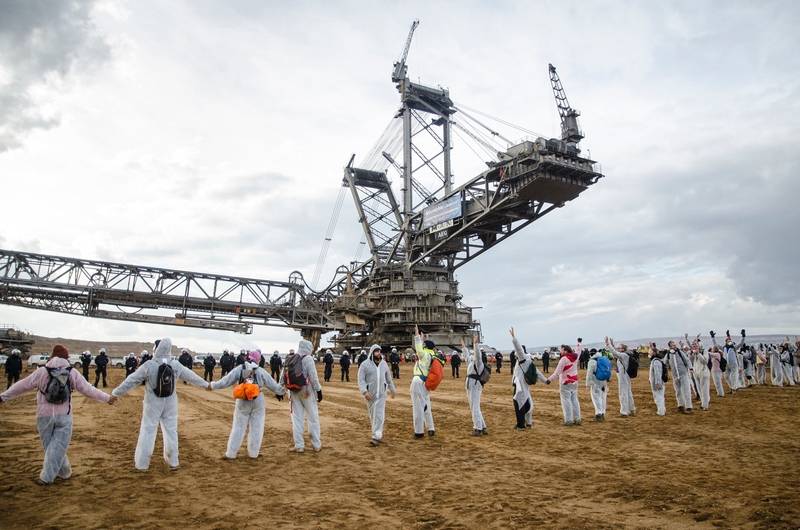29. February 2024Pathways to decarbonisation to the test of the just transition
Recent research shows how the four CINTRAN regions respond to increasing decarbonization pressures, and periodizes the occurring energy transition process. We find that: (i) regions that have a clear plan for workers’ transitions with funding attached are at an advantage in progressing to further transition phases; (ii) strategies of resistance, adaptation and transformation do not necessarily occur in sequence and movement between transition phases is not smooth.
How is energy transition faring in coal-intensive regions?
The European Green Deal, launched in 2019, aims to achieve climate neutrality by 2050, with a key focus on decarbonization. However, despite favorable regulatory frameworks, decarbonization efforts across the European Union (EU) have been uneven, particularly in regions heavily reliant on fossil fuel industries. This paper delves into the complexities of energy transition within four carbon-intensive regions: Western Macedonia (Greece), Ida-Virumaa (Estonia), Silesia (Poland), and North Rhine-Westphalia (NR-W) (Germany). By examining how these regions cope with decarbonization pressures and mapping their responses to various transition phases, this study aims to provide insights into the challenges and opportunities associated with transitioning away from coal and other fossil fuels.
Testing transition phase theory
The study explores the phases of energy transition and just transitions, aiming to understand the temporal dynamics of transitioning to a low-carbon economy and ensure fairness and equity throughout the process. The concept of transition phases refers to the stages a country or region typically undergoes as it shifts from a carbon-based to a low-carbon economy. These phases are characterized by different challenges and opportunities, including the availability of renewable energy sources, political will, and public support for decarbonization. The study draws from literature on technological diffusion, sustainability transitions, and socio-technical systems theory to create a diagnostic framework for understanding transition pathways in resource-dependent regions. Nacke et al. (2023) outline three phases of transition: stability, release & shutdown, and reorganization, across regional, industrial, and technological systems. They identify associated risks in each phase, such as lock-in, backlash from affected companies and workers, and regional despondency.
The concept of just transition, originating from the North American labor movement in the 1970s, emphasizes a fair and equitable transition from a carbon-based to a low-carbon economy. This includes engaging affected communities, building partnerships between stakeholders, and providing support and training for transitioning workers. Despite its adoption by governments in recent years, research on just transition dynamics is limited, particularly regarding temporal dynamics.
The study provides more insight into transition phases by showing that the switch from one phase to another happens differently depending on sectoral alignment and societal factors in each region. It underscores the significance of policy and financial measures, such as the Just Transition Fund, in enabling concrete change at local and regional levels. Transition phases may not always correspond to those highlighted in the literature and can vary across regions depending on historical context, socio-political factors, and interactions across different scales of government. By emphasizing sectoral focus and societal context, the study improves understanding of transition dynamics and enhance the prospects of a successful and just transition.
The press and the people
A mixed methods approach was used, combining media analysis, interviews with key stakeholders, and focus groups to gather data on coping strategies and regional dynamics. Media analysis spanned seven years (2015-2021), capturing major national and regional newspapers’ coverage of decarbonization-related issues. Semi-structured interviews were conducted with experts from NGOs, industry, consultancy firms, academia, and policymakers. Focus groups in each of the four regions gathered insights from local stakeholders representing diverse demographics and employment fields.

Ende-Gelände activists occupying the Hambach open-cast mine (by Tim Wagner, CC BY-NC-SA 2.0 DEED, https://flickr.com/photos/133937251@N05/38160933606)
The four case studies
The cross-case characteristics of the four regions—Ida-Virumaa in Estonia, North Rhine-Westphalia (NR-W) in Germany, Silesia in Poland, and Western Macedonia in Greece—reveal diverse socio-demographic, political, and economic backgrounds, each impacting the region’s energy supplies and transition prospects. Ida-Virumaa is located in north-eastern Estonia, it has a predominantly Russian population and a history of oil shale industry, contributing to regional employment but also environmental and health concerns.
NR-W is situated in west-central Germany, it’s the most populous region with a strong industrial tradition, notably in coal mining. Transition efforts have been ongoing since the 1950s, with a focus on economic diversification. Silesia is the main mining region in Poland. It faces a decline in coal production and mining jobs due to lower profitability and government restructuring programs. Like Ida-Virumaa, it lacked renewable energy infrastructure at the starting point of our analysis. Western Macedonia is known for lignite extraction: it faces high unemployment rates with significant job losses expected due to mine closures. At the beginning of our study period, it had some renewable energy infrastructure, particularly hydroelectric power plants.
Ida-Virumaa:
Period 1 (2015-2018): This period saw the oil shale industry destabilized by a drop in global oil prices, leading to layoffs and closures. The government responded with measures to stabilize employment and industry, including subsidies and restrictions on wind park development. However, these measures faced legal challenges and criticisms for their fairness.
Period 2 (2019-2021): As carbon prices rose, the profitability of oil shale declined further. Just transition rhetoric emerged, prompting discussions on phasing out oil shale and transitioning to renewables. Government actions included investments in renewables and job creation, but disagreements persisted over compensation and future visions for the region.
NR-W:
Period 1 (2015-2017): The government’s attempt to phase out coal faced resistance from regional and industrial stakeholders, leading to policy reversals and corporate restructuring. Energy giants shifted focus towards renewables, with RWE opening a wind farm on a former mine site.
Period 2 (2018-2021): The establishment of the Coal Commission marked a shift towards transformative actions. However, tensions arose over renewable infrastructure and local opposition to wind farms. Industries began investing in renewable energy and green initiatives, signaling a gradual transition away from coal.
Silesia:
Period 1 (2015): Mining strikes and protests against mine closures characterized this period, with resistance from unions and miners. Government changes temporarily eased tensions.
Period 2 (2016-2019): Renewable energy initiatives emerged alongside international collaborations, such as the Silesian Declaration of Solidarity and Just Transition. Studies on economic transformation were conducted, and new projects for renewable energy and electric vehicles were announced.
Period 3 (2020-2021): Tensions resurfaced over mining sector restructuring, but government commitments to keep mines active until 2049 were made. The establishment of the Just Transition Fund stimulated adaptive and transformative actions, with proposals for energy communities and renewable energy projects.
Western Macedonia:
Period 1 (2015-2017): Resistance actions followed the government’s divestment of a stake in PPC, raising concerns about job security. Local initiatives for a just transition fund and international collaborations were initiated.
Period 2 (2018-2019): Increased adaptive activities and international collaborations characterized this period, with regional debates on hydrogen fuel and the establishment of transition management committees.
Period 3 (2020-2021): The delivery of a Just Transition Plan and EU funding stimulated transformative actions, with projects for renewable energy, green hydrogen, and energy efficiency. However, protests over renewable projects highlighted local concerns and the need for community involvement in the transition.
Overall, the results demonstrate the complexities and challenges of transitioning away from fossil fuels in each region, with varying levels of resistance, adaptation, and transformative actions shaping the transition process. The establishment of just transition frameworks and international collaborations played significant roles in facilitating these transitions, but tensions and disagreements persisted, underscoring the importance of inclusive decision-making and community engagement in achieving a fair and sustainable transition.
Identifying transition phases
In Ida-Virumaa, the transition is characterized by resistance followed by adaptation to EU policies on emissions. The region is a transitional phase between Phases 1 and 2. The government initially maintained a status quo position but shifted towards flexibility with the implementation of the EU’s Just Transition Fund. NR-W, on the other hand, has advanced to Phase 2 with significant economic diversification and industrial maturity, although social policies lag behind. Silesia can be categorized as transitioning from Phase 1 to 2: it faces challenges due to strong lock-in, with resistance from unions and the government supporting the coal industry. Western Macedonia has shown characteristics of Phase 2 transition: however, despite economic diversification, it still faces limitations in transitioning due to the region’s destabilized extractive industry.
Strategies in these regions oscillate between resistance, adaptation, and transformation, with actions often conflicting or aligning with different goals. Resistance to fossil fuel phase-out is common in Phase 1 to Phase 2 transitions, but later phases see resistance towards renewable energy development. Civil society plays a variable role, initially supporting coal industries but becoming more open to change as transitions progress.
The alignment between scales, actors, and levels is crucial for transition progress. National governments may face opposition from local sectors, but broader participation and international policies can facilitate alignment. The presence of clear transition plans with funding attached accelerates progress, as seen with the EU’s Just Transition Fund.
Regional characteristics such as economic diversification and historical context influence transition pathways. Smaller regions with a single national resource dependency transition more slowly, while cultural factors and historical industry reliance affect political inertia and transition delays.
In conclusion, the transition process is complex, with strategies evolving over time and influenced by various factors including political, economic, and cultural contexts. The text suggests the need for deeper just transitions perspectives and broader geographical scope in future research to better understand and support transition conditions. Additionally, recent geopolitical events like the Russian invasion of Ukraine have altered transition plans, highlighting the importance of adapting strategies to new challenges and motivations.
Authors
Roberto Cantoni
Senior Researcher | Universitat Autònoma de Barcelona
ICTA
Marie Claire Brisbois
Senior Lecturer | University of Sussex
SPRU


Funding
The CINTRAN project has received funding from the European Union’s Horizon 2020 research and innovation programme under grant agreement No. 884539. The sole responsibility for the content of this website lies with the authors and does not necessarily reflect the opinion of CINEA or other EU agencies or bodies.